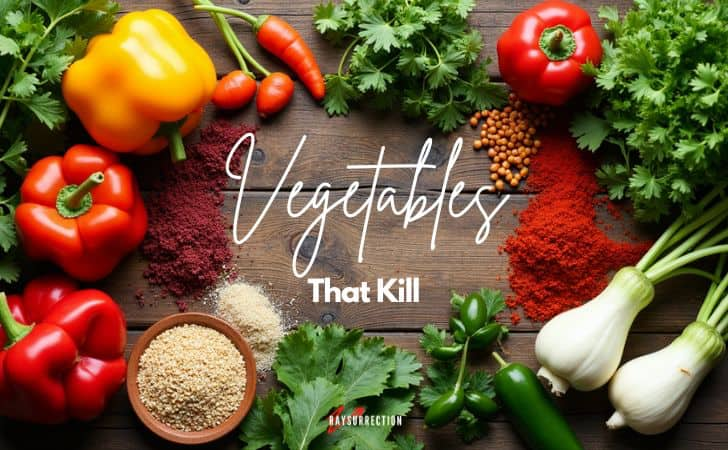Vegetables are often hailed as the cornerstone of a healthy diet, packed with nutrients and fiber. Yet, beneath their vibrant colors and wholesome reputation lies a darker truth: some vegetables harbor deadly potential. This article uncovers the mind-boggling, eye-opening dangers lurking in certain plants, far beyond common knowledge. Prepare to rethink what you put on your plate.
Deadly Compounds in Everyday Vegetables
Certain vegetables contain natural toxins that can harm or kill in specific conditions. These compounds, often produced as defense mechanisms by plants, remain under-discussed despite their potency. Awareness of these risks is critical to avoid unintended consequences. The following cases reveal the hidden lethality in familiar produce.
- Cassava roots harbor cyanogenic glycosides, which release cyanide in the body if not properly processed.Improper preparation, such as inadequate soaking or cooking, allows these compounds to break down into hydrogen cyanide, a lethal poison. Consuming raw or undercooked cassava has led to fatalities in regions where it’s a staple, with symptoms including dizziness, nausea, and, in severe cases, death.
- Raw kidney beans contain phytohaemagglutinin, a toxin that causes severe gastrointestinal distress. As few as four or five raw beans can trigger vomiting, diarrhea, and abdominal pain within hours. In extreme cases, hospitalization has occurred, particularly when beans are consumed in undercooked dishes like slow-cooker recipes.
- Green potatoes produce solanine, a neurotoxin that can be fatal in high doses. Exposure to light or improper storage causes potatoes to turn green and accumulate solanine, which resists cooking. Historical cases link solanine poisoning to symptoms like delirium, coma, and death, especially in children who ate improperly stored potatoes.
Misidentified Wild Vegetables
Foraging for wild edibles has surged in popularity, but mistaking toxic plants for edible vegetables can be deadly. Many wild plants resemble common vegetables, yet harbor lethal compounds. Misidentification often stems from overconfidence or lack of expertise. These cases highlight the perils of foraging without precise knowledge.
- Wild parsnip, often mistaken for wild carrot, contains psoralens that cause severe skin burns and systemic toxicity. Contact with its sap, followed by sunlight exposure, triggers photodermatitis, leading to blisters and long-term skin damage. Ingesting large amounts has caused fatalities due to organ failure in unsuspecting foragers.
- Hemlock, confused with edible wild greens like parsley, is one of the most poisonous plants known. Its alkaloids, including coniine, paralyze the respiratory system, causing death within hours. Historical records, including Socrates’ death, tie hemlock ingestion to rapid, irreversible neurological shutdown.
- False morels, mistaken for edible mushrooms often classified as wild vegetables, contain gyromitrin, a toxin that metabolizes into rocket fuel-like compounds. Eating them causes vomiting, seizures, and liver failure, with a mortality rate of up to 30%. Misidentification in foraging groups has led to entire families succumbing after a single meal.
Toxins Amplified by Preparation Errors
Even safe vegetables can turn deadly through improper preparation or storage. Toxins can accumulate or activate due to mishandling, transforming benign produce into health hazards. These risks are often overlooked in modern kitchens. Below are instances where preparation errors proved fatal.
- Moldy sweet potatoes produce ipomeamarone, a toxin that causes lung edema and death. Fungal growth, often invisible, occurs when sweet potatoes are stored in damp, warm conditions. Inhaling or ingesting the toxin has killed livestock and humans, with cases reported in rural communities relying on stored crops.
- Sprouted mung beans can develop bacterial toxins like Bacillus cereus when soaked too long. Extended soaking in warm water creates a breeding ground for bacteria, leading to food poisoning. Severe cases have caused organ failure in individuals consuming large quantities of improperly sprouted beans.
- Fermented cabbage, when mishandled, fosters botulism, a neurotoxin-producing bacteria. Home fermentation without proper sterilization allows Clostridium botulinum to thrive, releasing a toxin that paralyzes muscles. Documented outbreaks link botulism to homemade sauerkraut, with victims requiring intensive care or facing death.
Genetic Modifications and Unintended Consequences
Genetically modified vegetables, designed to boost yield or resist pests, can introduce unforeseen dangers. While intended to improve food security, some modifications amplify natural toxins or create new ones. Regulatory gaps and limited long-term studies exacerbate these risks. The following cases expose the hidden threats of engineered produce.
- Certain GMO potatoes increase solanine production under stress conditions like drought. Genetic tweaks to enhance pest resistance inadvertently upregulate toxin synthesis, making these potatoes riskier than their non-GMO counterparts. Field studies have linked these potatoes to livestock deaths and human illness in regions adopting them without rigorous testing.
- Modified eggplants, engineered for pest resistance, can accumulate higher levels of glycoalkaloids. These compounds, naturally present in nightshades, cause neurological symptoms and, in rare cases, death when consumed in excess. Farmers in developing nations reported poisoning cases after eating large quantities of these eggplants, unaware of their altered chemistry.
- GMO corn varieties, altered for herbicide tolerance, may concentrate mycotoxins during fungal infections.These toxins, produced by molds like Aspergillus, cause liver damage and cancer at high doses. Outbreaks of mycotoxin poisoning have been traced to modified corn in regions with poor storage infrastructure.
Environmental Contamination in Vegetables
Vegetables grown in contaminated environments can absorb or accumulate deadly substances. Soil, water, and air pollution introduce toxins that plants cannot filter out. These contaminants often go undetected until consumption causes harm. Below are cases where environmental factors turned vegetables into silent killers.
- Spinach grown in heavy metal-contaminated soil absorbs cadmium, a carcinogen that causes kidney failure. Industrial runoff or mining waste often taints agricultural land, allowing cadmium to accumulate in leafy greens. Chronic exposure through regular consumption has led to fatal organ damage in affected regions.
- Rice cultivated in arsenic-laden water concentrates this metalloid, linked to cancer and heart failure.Flooded rice paddies, common in certain countries, absorb arsenic from groundwater, with no visible signs on the plant. Long-term consumption has caused mass poisoning events, with thousands affected in areas like Bangladesh.
- Lettuce near industrial sites can accumulate polychlorinated biphenyls (PCBs), neurotoxic compounds banned but persistent in soil. These chemicals disrupt hormonal and nervous systems, leading to death in extreme cases. Urban farming initiatives have unknowingly harvested contaminated lettuce, sickening consumers.
We earn a commission if you click this image and make a purchase at no additional cost to you.
Rare Allergic Reactions to Vegetables
While allergies to vegetables are uncommon, certain rare reactions can be fatal. These anaphylactic responses stem from obscure proteins or cross-reactivity with other allergens. Misdiagnosis or delayed treatment often escalates the danger. The following cases illustrate the lethal potential of these rare allergies.
- Celery can trigger anaphylaxis in individuals with mugwort-celery syndrome, a cross-reactive allergy.Consuming raw celery causes throat swelling, breathing difficulty, and, in severe cases, death within minutes. European cases have documented fatalities in individuals unaware of their sensitivity after eating celery-heavy dishes.
- Fava beans cause hemolytic anemia in people with G6PD deficiency, a genetic condition. The beans’ vicine and convicine compounds destroy red blood cells, leading to organ failure if untreated. Mediterranean populations, where the deficiency is prevalent, have reported deaths after consuming fresh fava beans.
- Raw taro root contains calcium oxalate crystals, which can cause throat swelling and asphyxiation in hypersensitive individuals. Improper cooking leaves these crystals intact, triggering severe allergic reactions. Pacific Island communities have recorded fatalities from eating undercooked taro in traditional dishes.
Vegetables That Kill: A Hidden Threat
Vegetables, often seen as harmless pillars of nutrition, can conceal deadly risks that defy common assumptions. From natural toxins and misidentification to preparation errors, genetic modifications, environmental contamination, and rare allergies, the dangers are as varied as they are shocking.
Awareness and caution can mitigate these threats, but ignorance can prove fatal. Next time you reach for that vibrant produce, consider the hidden perils it might hold.





